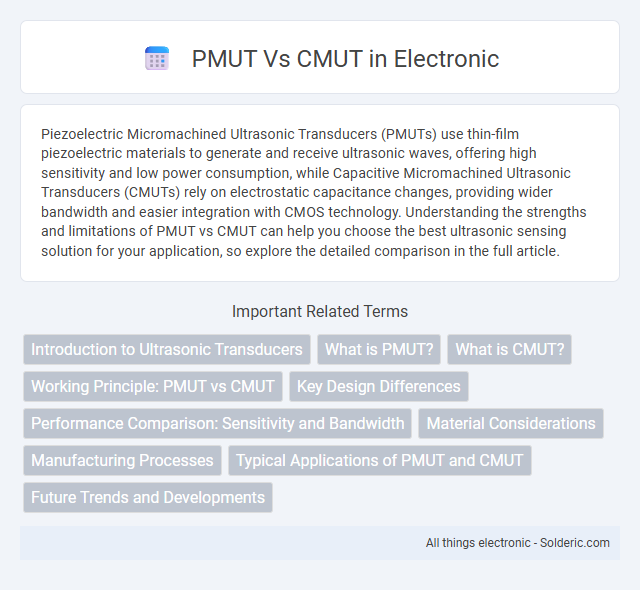Piezoelectric Micromachined Ultrasonic Transducers (PMUTs) use thin-film piezoelectric materials to generate and receive ultrasonic waves, offering high sensitivity and low power consumption, while Capacitive Micromachined Ultrasonic Transducers (CMUTs) rely on electrostatic capacitance changes, providing wider bandwidth and easier integration with CMOS technology. Understanding the strengths and limitations of PMUT vs CMUT can help you choose the best ultrasonic sensing solution for your application, so explore the detailed comparison in the full article.
Comparison Table
| Feature | PMUT (Piezoelectric Micromachined Ultrasonic Transducer) | CMUT (Capacitive Micromachined Ultrasonic Transducer) |
|---|---|---|
| Operating Principle | Piezoelectric effect | Capacitive effect (electrostatic) |
| Material | Piezoelectric thin films (PZT, AlN) | Silicon membrane with vacuum gap |
| Frequency Range | 100 kHz to 10 MHz | 1 MHz to 50 MHz |
| Bandwidth | Moderate bandwidth | Wide bandwidth |
| Fabrication Complexity | Moderate | Higher, requires vacuum sealing |
| Sensitivity | High mechanical sensitivity | High electrical sensitivity |
| Power Consumption | Lower | Higher (requires DC bias) |
| Typical Applications | Medical imaging, range finding | High-resolution imaging, sensing |
| Advantages | Robust, simpler electronics | Broad bandwidth, high resolution |
| Limitations | Limited bandwidth, moderate frequency range | Complex fabrication, DC bias needed |
Introduction to Ultrasonic Transducers
Ultrasonic transducers convert electrical energy into mechanical vibrations for imaging and sensing applications, with PMUTs (Piezoelectric Micromachined Ultrasonic Transducers) and CMUTs (Capacitive Micromachined Ultrasonic Transducers) representing two advanced MEMS-based technologies. PMUTs utilize piezoelectric materials such as PZT or AlN to generate ultrasonic waves through mechanical deformation, offering high sensitivity and compatibility with standard CMOS processes. CMUTs rely on electrostatic forces between a flexible membrane and a fixed electrode to produce vibrations, enabling wider bandwidth and better integration with microelectronics for high-resolution imaging.
What is PMUT?
PMUT (Piezoelectric Micromachined Ultrasonic Transducer) is a MEMS-based ultrasonic device that uses piezoelectric materials to generate and receive ultrasonic waves through mechanical vibrations of a thin membrane. Unlike CMUT (Capacitive Micromachined Ultrasonic Transducer), which operates based on electrostatic principles, PMUT offers advantages in sensitivity and impedance matching due to the direct piezoelectric effect. PMUTs are widely used in medical imaging, gesture recognition, and proximity sensing applications because of their compact size and efficient energy conversion.
What is CMUT?
A Capacitive Micromachined Ultrasonic Transducer (CMUT) uses a capacitive membrane structure to generate and receive ultrasonic waves, offering a wider bandwidth and higher sensitivity compared to traditional piezoelectric devices like PMUTs. CMUT technology enables more precise imaging and better performance in medical diagnostics and industrial applications. Your choice between PMUT and CMUT depends on factors such as frequency range, resolution, and application-specific requirements.
Working Principle: PMUT vs CMUT
Piezoelectric Micromachined Ultrasonic Transducers (PMUTs) operate based on the piezoelectric effect, converting electrical signals into mechanical vibrations through a piezoelectric membrane that generates ultrasound waves. Capacitive Micromachined Ultrasonic Transducers (CMUTs) utilize electrostatic forces between a fixed substrate and a flexible membrane, where applying a voltage causes membrane displacement to produce ultrasonic waves. The fundamental difference lies in PMUTs relying on material properties for ultrasound generation, while CMUTs depend on capacitance changes within a vacuum gap for transduction.
Key Design Differences
PMUT (Piezoelectric Micromachined Ultrasonic Transducers) utilize piezoelectric materials that convert electric signals into mechanical vibrations, offering a simpler fabrication process with lower voltage operation. CMUT (Capacitive Micromachined Ultrasonic Transducers) rely on electrostatic forces between conductive membranes and substrates, enabling wider bandwidth and higher sensitivity but requiring complex vacuum sealing. Your choice depends on specific application needs, balancing fabrication complexity, power consumption, and acoustic performance.
Performance Comparison: Sensitivity and Bandwidth
PMUTs (Piezoelectric Micromachined Ultrasonic Transducers) exhibit higher sensitivity due to the direct piezoelectric effect, making them ideal for applications requiring precise ultrasonic detection. CMUTs (Capacitive Micromachined Ultrasonic Transducers) offer broader bandwidth because of their capacitive design, enabling better frequency range and improved axial resolution. Your choice depends on whether sensitivity or bandwidth is prioritized for optimal ultrasonic sensing performance.
Material Considerations
PMUTs (Piezoelectric Micromachined Ultrasonic Transducers) typically utilize piezoelectric thin films such as PZT (lead zirconate titanate) or AlN (aluminum nitride), offering strong electromechanical coupling and high sensitivity. CMUTs (Capacitive Micromachined Ultrasonic Transducers) rely on silicon-based membranes and vacuum cavities, providing broad bandwidth and easier integration with CMOS processes but often requiring complex fabrication. Your choice between PMUT and CMUT will depend on factors like desired frequency range, sensitivity, and compatibility with existing material platforms for optimal ultrasonic performance.
Manufacturing Processes
PMUT (Piezoelectric Micromachined Ultrasonic Transducers) manufacturing processes typically involve thin-film deposition, etching, and microfabrication techniques compatible with standard CMOS technology, enabling scalable and cost-effective production. CMUT (Capacitive Micromachined Ultrasonic Transducers) production requires complex wafer bonding, vacuum cavity creation, and precise membrane formation, making fabrication more challenging and potentially more expensive. Understanding these differences in manufacturing processes can help you select the optimal transducer technology based on application-specific cost and integration requirements.
Typical Applications of PMUT and CMUT
PMUT (Piezoelectric Micromachined Ultrasonic Transducers) are commonly used in medical imaging, fingerprint sensing, and gesture recognition due to their high sensitivity and low power consumption. CMUT (Capacitive Micromachined Ultrasonic Transducers) find typical applications in underwater sonar, nondestructive testing, and high-frequency medical imaging, benefiting from their wide bandwidth and ease of integration with electronics. Both PMUT and CMUT technologies play critical roles in advancing ultrasonic sensing across healthcare, industrial inspection, and consumer electronics.
Future Trends and Developments
Future trends in PMUT (Piezoelectric Micromachined Ultrasonic Transducers) and CMUT (Capacitive Micromachined Ultrasonic Transducers) emphasize enhancements in power efficiency, miniaturization, and bandwidth expansion, critical for medical imaging and industrial sensing. Advances in material science, such as novel piezoelectric thin films for PMUTs and improved MEMS fabrication for CMUTs, are driving higher sensitivity and integration with microelectronics. Emerging hybrid transducer technologies and AI-driven signal processing are expected to further elevate performance, enabling next-generation diagnostic and nondestructive testing applications.
PMUT vs CMUT Infographic

 solderic.com
solderic.com